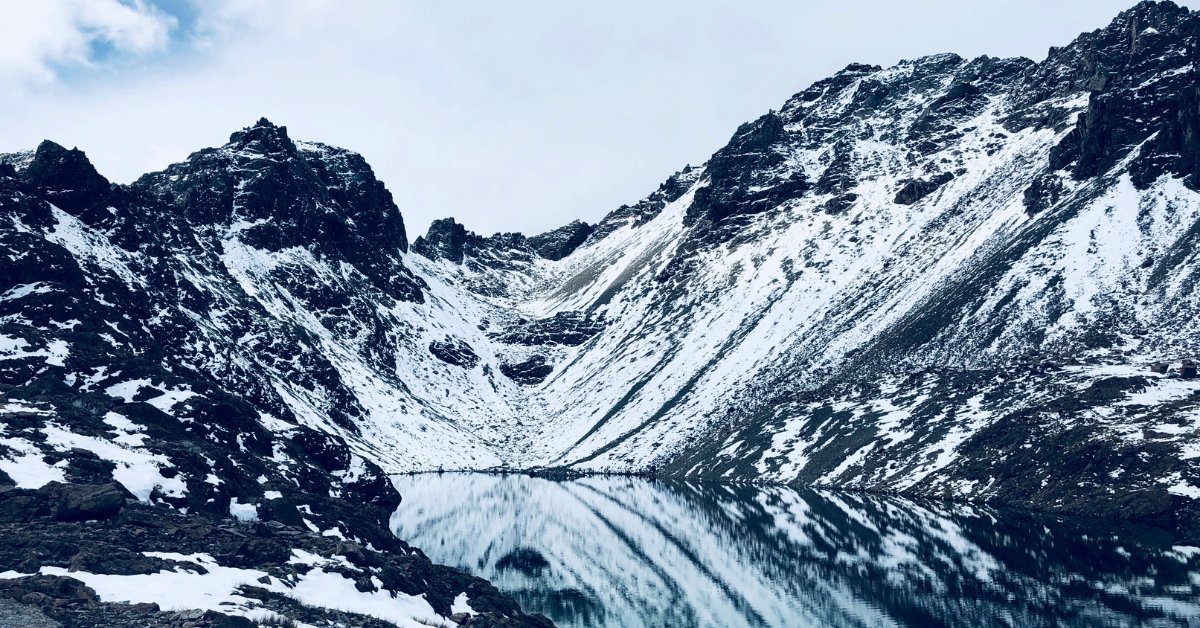When snowfall starts in Sikkim, from Yumthang Valley to Nathula Pass, plan your winter adventure with our guide to the best snowy spots!
Table Of Contents
Snowfall In Sikkim
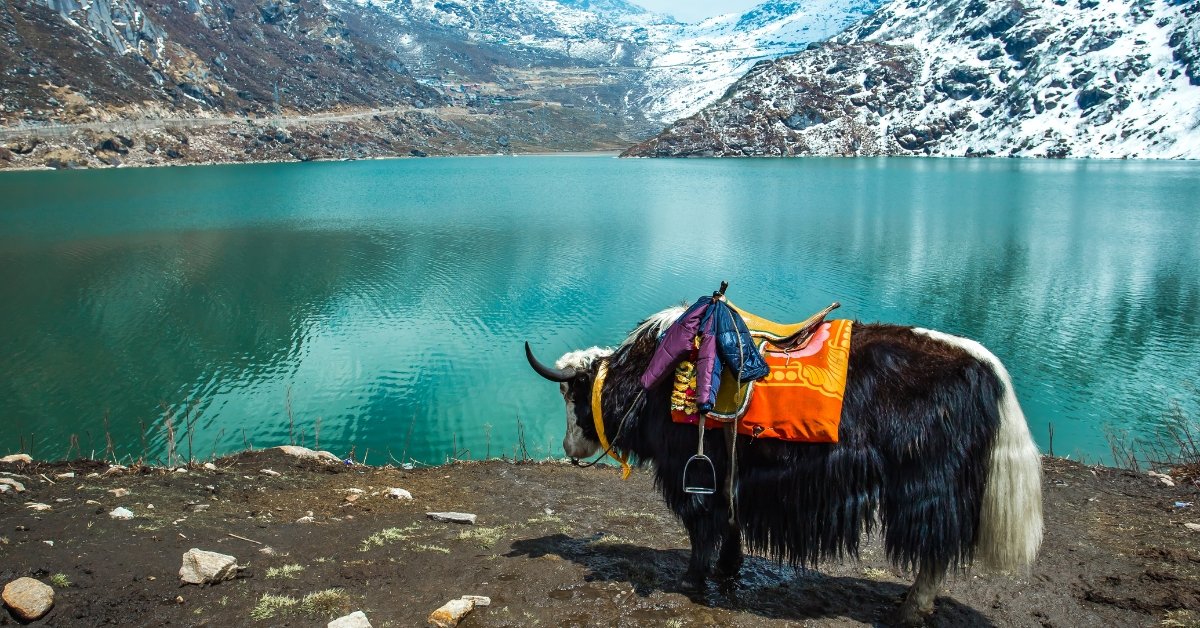
Hey there, snow chasers!
Sikkim is your go-to destination if you dream of a winter escape where snowflakes dance against the backdrop of the mighty Himalayas.
However, when does the magic of snowfall start in this Northeastern gem?
Whether you are eyeing the high-altitude wonderlands like Yumthang Valley or the more accessible Tsomgo Lake, timing your trip right is key to catching Sikkim’s snowy spectacle.
As THOUSIF Inc. – INDIA, we are here to provide all the details on when and where to experience snowfall in Sikkim, along with insider tips to make your trip unforgettable.
So grab a hot chai, cozy up, and let us explore Sikkim’s frosty charm!
Why Sikkim’s Snowfall Is A Must-See

Sikkim, nestled in the lap of the Himalayas, transforms into a winter wonderland when snow blankets its peaks and valleys.
From the serene Gurudongmar Lake to the adventure-packed Nathula Pass, snowfall adds a layer of magic that draws travelers from across the globe.
However, here is the thing: Sikkim’s diverse altitudes mean snowfall varies wildly from place to place.
Higher regions like Zero Point and Lachen get dusted early, while lower spots like Gangtok rarely see more than a light flurry.
Knowing when and where to go is crucial, especially since heavy snow can block roads or make high-altitude treks a no-go.
In this guide, we will break down the snowfall seasons, highlight the best spots to catch those flakes, and share the latest weather updates to help you plan a trip that’s as smooth as a snow-covered slope.
Let us get started!
When Does Snowfall Start In Sikkim?
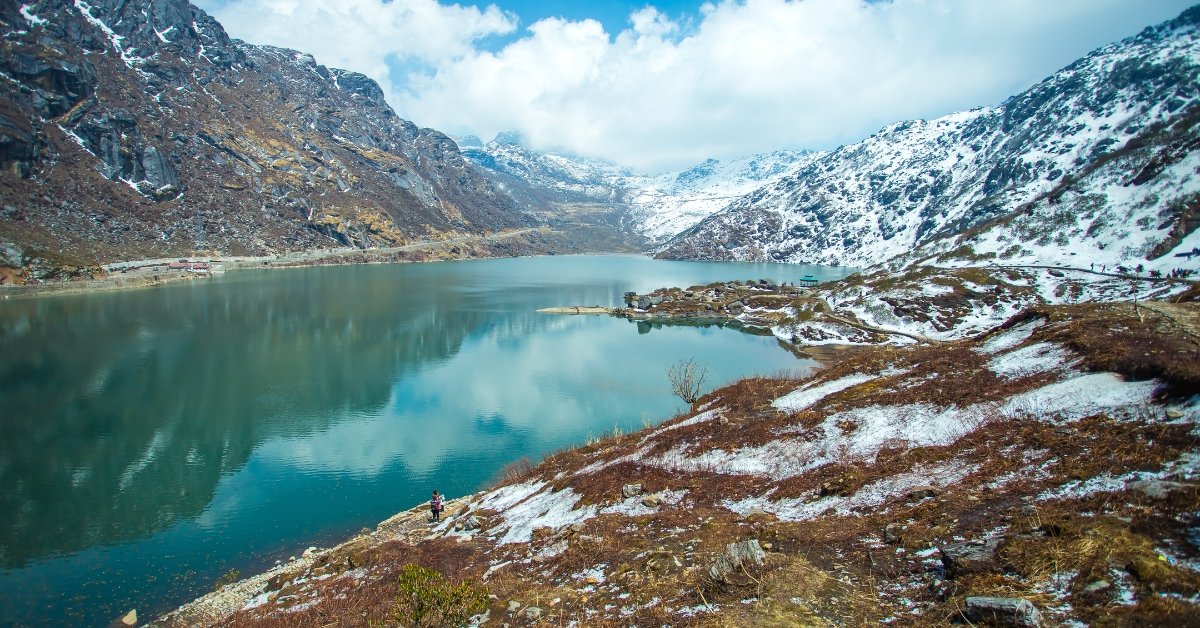
Sikkim’s snowfall season typically kicks off in late November and stretches through February, with December and January being the peak months for heavy snow.
However, the timing depends heavily on altitude and location.
Higher-altitude areas like Yumthang Valley, Zero Point, Lachen, Lachung, and Gurudongmar Lake often see snow as early as late September or October, especially in years like 2024 when early snowfall surprised places like Thangu.
Lower areas like Gangtok rarely get snowfall at around 5,840 feet, but nearby spots like Tsomgo Lake and Nathula Pass become snowy havens from December to February.
Snow starts to taper off by March, though higher regions may still see light flurries.
To give you a clearer picture, here is a breakdown of snowfall timing across Sikkim’s regions:
| Region | Altitude(ft) | Snowfall | Peak | Notes |
|---|---|---|---|---|
| Yumthang Valley | 11,800 | Late Sep – Mar | Dec – Jan | Heavy snow; roads may close; hot springs offer warmth. |
| Zero Point | 15,000 | Late Sep – Apr | Dec – Jan | Year-round snow at times; civilian road ends here. |
| Lachen | 8,800 | Oct – Mar | Dec – Jan | Gateway to Gurudongmar; heavy snow in winter. |
| Lachung | 9,000 | Oct – Mar | Dec – Jan | Access to Yumthang; stunning snow-covered monasteries. |
| Gurudongmar Lake | 17,800 | Late Sep – Mar | Dec – Jan | Frozen lake; permits required; high-altitude precautions needed. |
| Tsomgo Lake | 12,313 | Nov – Feb | Dec – Jan | Frozen Lake, yak rides, and a ropeway for aerial views. |
| Nathula Pass | 14,140 | Nov – Feb | Dec – Jan | Heavy snow; border area; permits needed; roads may close. |
| Gangtok | 5,840 | Access to Yumthang, stunning snow-covered monasteries. | Dec – Jan (if any) | Snow is unlikely; base is for exploring nearby snowy areas. |
Snowfall In Higher-Altitude Regions
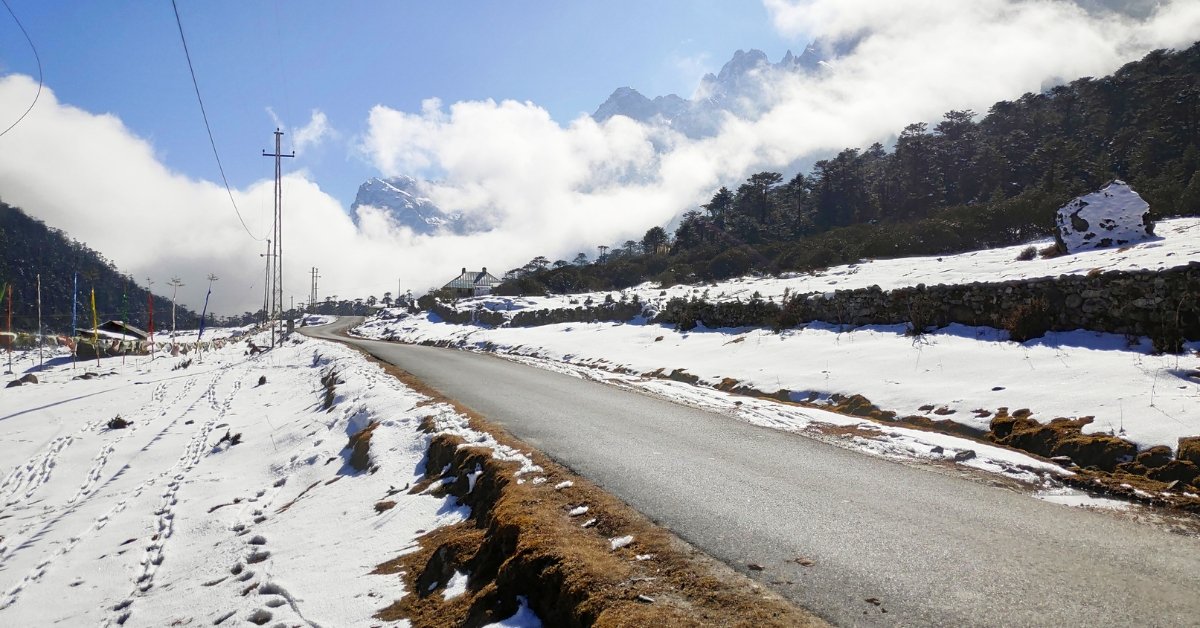
Yumthang Valley: The Valley Of Snowy Flowers
Yumthang Valley, often called the “Valley of Flowers,” transforms into a snowy paradise from late September to March.
At 11,800 feet, this North Sikkim gem sees heavy snowfall in December and January, making it ideal for skiing, snowboarding, or just soaking in the surreal beauty.
The valley’s hot springs are a perfect way to warm up after a day of snow play.
However, roads to Yumthang can close due to heavy snow, so always check conditions before heading out.
In 2024, early snow in late September dusted the valley, hinting at a robust winter season.
Pro Tip: Stay in Lachung (about 25 km away) for easier access and cozy homestays. Pack thermals and windproof jackets; temperatures can dip to -5°C to 5°C during the day and lower at night.
Zero Point: Where Roads End And Snow Begins
At a staggering 15,000 feet, Zero Point (or Yumesamdong) is where the civilian road ends and the snow begins, sometimes year-round!
Snowfall starts as early as late September and continues through April, with December to January offering the thickest snow cover.
The sight of snow-clad mountains and frozen rivers is breathtaking, but the high altitude requires acclimatization to avoid Acute Mountain Sickness (AMS).
Permits are required, so plan.
Fun Fact: Zero Point is named because it is the end of the road for civilians—no further travel is allowed due to its proximity to the border.
Lachen and Lachung: Twin Snowy Villages
These twin villages in North Sikkim, at 8,800 and 9,000 feet, respectively, are gateways to some of Sikkim’s snowiest spots.
Snowfall begins in October and peaks from December to January, blanketing Lachen and Lachung in pristine white.
Lachen is the base for Gurudongmar Lake, while Lachung leads to Yumthang and Zero Point.
Both villages offer homestays and a chance to experience local Sikkimese culture amidst snow-covered landscapes.
Temperatures range from -5°C to 5°C during the day and drop to -10°C or lower at night.
Travel Tip: Book accommodations in advance as options dwindle in peak winter. The Lachung Monastery, with its 19th-century charm, is a must-visit for a cultural touch.
Gurudongmar Lake: A Frozen Sacred Gem
At 17,800 feet, Gurudongmar Lake is one of the highest lakes in the world and a spiritual haven for Hindus, Buddhists, and Sikhs.
Snowfall starts in late September, and by December, the Lake is often frozen, except for a small patch believed to be blessed by Guru Padmasambhava.
The surrounding snow-capped peaks, including Kanchenjunga, create a jaw-dropping vista.
However, the high altitude and sub-zero temperatures (-20°C to -3°C in November) demand caution.
Permits are mandatory, and a stopover in Lachen is recommended for acclimatization.
Heads-Up: Oxygen levels are low here, so consult a doctor if you have respiratory issues. Carry portable oxygen if possible.
Snowfall In Lower Areas
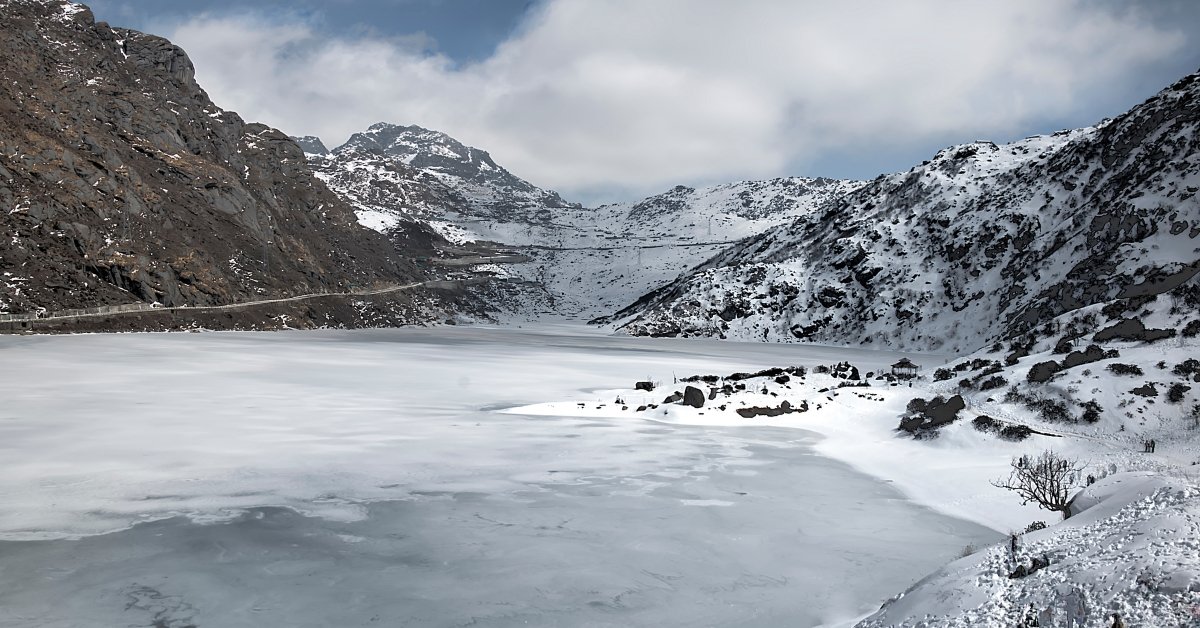
Gangtok: The Snowless Capital
At 5,840 feet, Gangtok is Sikkim’s bustling capital and a base for exploring snowy destinations.
Snowfall here is rare and usually limited to light flurries in December or January, if at all.
The city’s pleasant winter temperatures (5°C to 16°C in November) make it an excellent hub for day trips to snowier spots like Tsomgo Lake or Nathula Pass.
Gangtok’s monasteries, like Rumtek and Tsuklakhang, offer cultural immersion, while Tashi View Point gives you a glimpse of snowy Kanchenjunga on clear days.
Why Visit? Gangtok’s vibrant markets and cozy cafes are perfect for unwinding after a snowy adventure. Try local momos and thukpa to warm up!
Tsomgo Lake: A Frozen Wonderland
Located 40 km from Gangtok at 12,313 feet, Tsomgo (or Changu) Lake is a must-visit for snow lovers.
Snowfall begins in November and peaks in December and January, often freezing the Lake’s surface.
Surrounded by snow-capped mountains, it is a hotspot for yak rides, snow play, and ropeway rides offering aerial views.
In February 2025, heavy snowfall kept the Lake accessible, but roads beyond Nathula Pass were blocked, so plan accordingly.
In March, temperatures range from 0°C to 10°C during the day and drop to -5°C at night.
Activity Alert: Try a yak ride for a quirky, snow-dusted experience. Do not forget your camera for those Instagram-worthy shots!
Nathula Pass: Snow on The Border
At 14,140 feet, Nathula Pass is a historic Indo-China border point and a prime snowfall destination from November to February.
Heavy snow in December and January creates a stunning white landscape, but road closures are common, as seen in February 2025 when a snowstorm blocked access.
Permits are required, and the pass’s high altitude means temperatures can dip to -10°C to 0°C in March.
Nearby, the Baba Harbhajan Singh Temple adds a spiritual touch to your snowy adventure.
Safety Note: Check road conditions with local authorities, as snow gear may be needed for safe travel.
Latest Weather Updates For 2024-2025

Based on the latest reports, Sikkim’s winter tourism season 2024 2025 is off to a strong start, with early snowfall recorded in late September 2024 in high-altitude areas like Thangu and Gurudongmar Lake.
A powerful snowstorm in February 2025 disrupted travel to Nathula Pass and Baba Mandir, indicating that heavy snowfall can impact accessibility even in peak season.
The Indian Meteorological Department (IMD) forecasts continued snowfall in higher altitudes through March 2025, with dense fog and strong winds possible in some areas.
Lower regions like Gangtok are expected to remain chilly but snow-free, with temperatures averaging 10°C to -4°C in January.
Before traveling, check with local tourism boards or websites like the IMD for real-time updates, as road blockages are common during heavy snow.
North Sikkim’s tourism sector is optimistic.
Repairs are underway on routes like National Highway 10 to ensure access during peak winter months.
Best Time To Visit For Snowfall
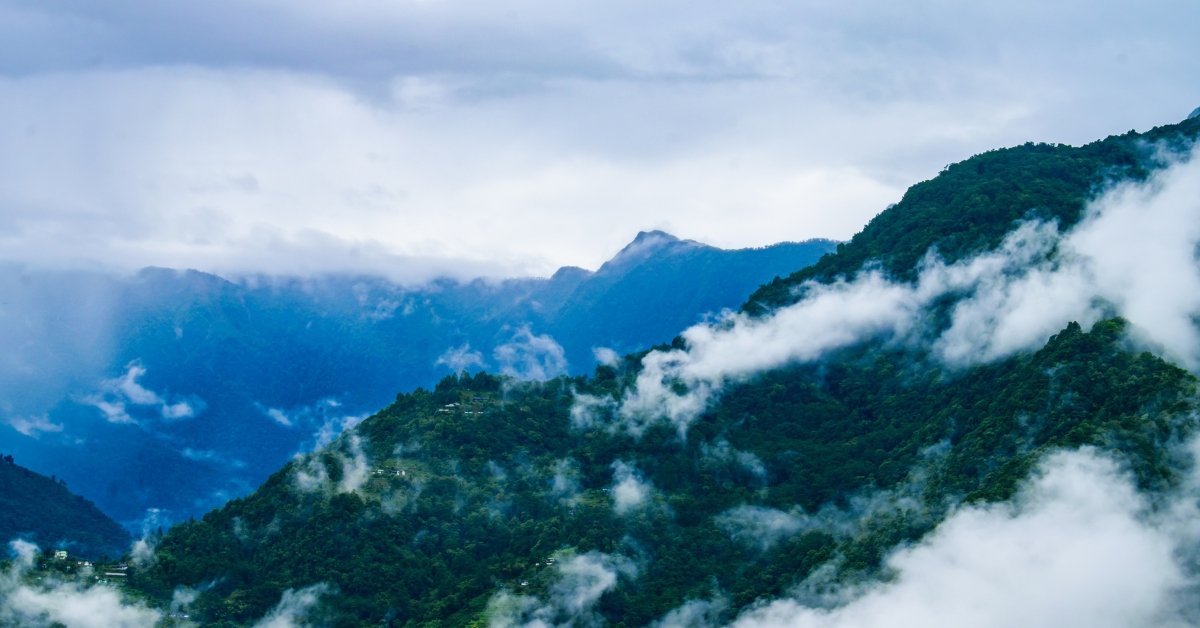
To catch Sikkim’s snowfall at its finest, plan your trip between late November and February, with December and January offering the heaviest snow.
Here is a month-by-month guide:
| Month | Snowfall | Places | Activities |
|---|---|---|---|
| Late Sep – Oct | Early snow in high altitudes | Yumthang, Zero Point, Gurudongmar | Photography, light trekking, sightseeing |
| Nov | Moderate snowfall | Tsomgo Lake, Nathula Pass, Lachen, Lachung | Snow play, yak rides, monastery visits |
| Dec – Jan | Heavy snowfall | Yumthang, Zero Point, Gurudongmar, Nathula | Skiing, snowboarding, snow fights |
| Feb | Heavy to moderate snowfall | Tsomgo Lake, Nathula, Lachen, Lachung | Winter camping, paragliding, and snow play |
| Mar | Light snowfall in high areas | Yumthang, Zero Point, Gurudongmar | Short treks, photography, and cultural festivals |
Note: By March, snow starts melting in lower areas, but higher regions like Zero Point may still have patches of snow, especially in the first week.
Tips For Planning Your Snowy Sikkim Adventure
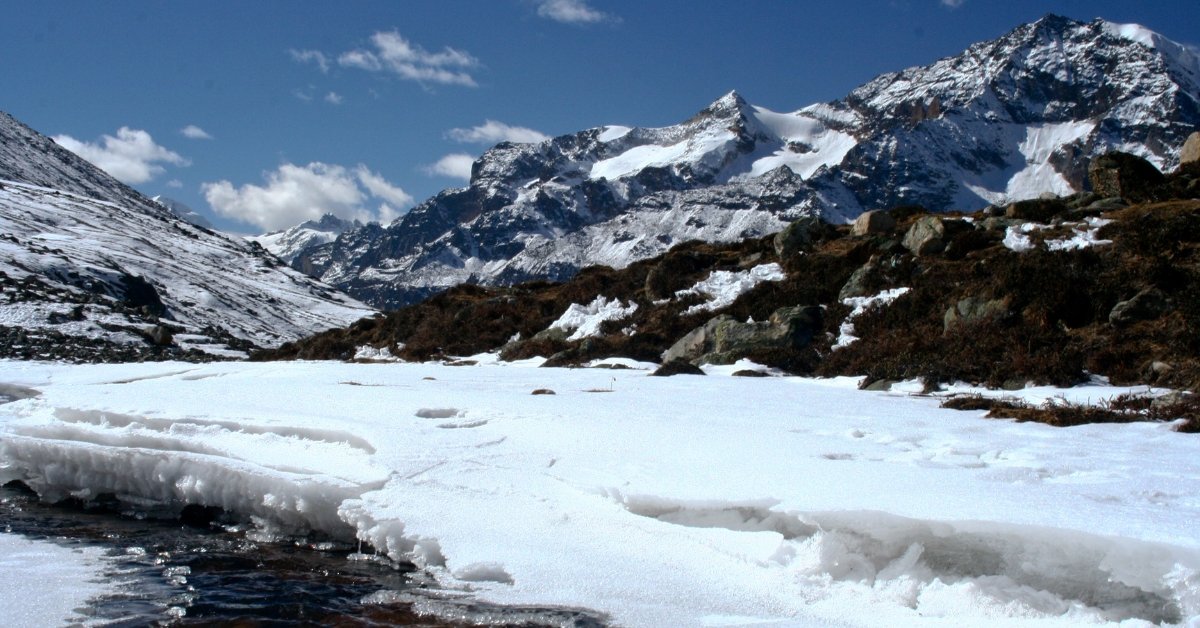
- Check Road Conditions: Heavy snowfall can block Nathula Pass, Gurudongmar Lake, and Yumthang Valley roads. Always confirm accessibility with local guides or tourism offices.
- Get Permits: Restricted areas like Nathula Pass, Gurudongmar Lake, and Zero Point require Protected Area Permits. Apply 1-2 days in advance through authorized tour operators or in Gangtok.
- Pack Smart: For high-altitude areas, bring thermals, windproof jackets, gloves, and sturdy boots. Sunglasses and sunscreen are also musts to protect against snow glare.
- Acclimatize: High-altitude spots like Gurudongmar and Zero Point can cause AMS. Spend a night in Lachen or Lachung to adjust.
- Book Early: Homestays and hotels in Lachen and Lachung fill up fast in winter. Reserve in advance for the best options.
- Hire Experienced Drivers: Sikkim’s twisty, snow-covered roads require skilled drivers familiar with the terrain.
- Stay Updated: Follow weather forecasts from reliable sources like the IMD to avoid getting caught in snowstorms.
Fun Activities To Enjoy In Sikkim’s Snow

Sikkim’s snowfall is not just about pretty views but also a playground for winter adventures!
Here are some must-try activities:
- Skiing and Snowboarding: Yumthang Valley and Nathula Pass offer powdery slopes for thrill-seekers. Equipment rentals are available in designated areas.
- Yak Rides: Hop on a colorful yak at Tsomgo Lake or Yumthang for a unique snowy ride.
- Snow Fights and Snowmen: Perfect for families or friends, especially at Zero Point or Lachung.
- Winter Camping: Set up camp near Tsomgo Lake or Yumthang for a cozy night under starry, snow-lit skies.
- Photography: Capture the frozen beauty of Gurudongmar Lake or the snow-draped Kanchenjunga from Tashi View Point.
- Cultural Immersion: Visit monasteries like Lachung Gompa or Rumtek during light snowfall for a serene experience.
Conclusion: Plan Your Snowy Sikkim Escape!

Sikkim’s snowfall is a bucket-list experience, turning its rugged peaks and serene valleys into a winter fairytale.
Whether chasing heavy snow in Yumthang Valley or enjoying a frozen lake at Tsomgo, timing your trip between late November and February ensures the best snowy vistas.
Higher altitudes like Zero Point and Gurudongmar Lake may surprise you with early snow in September or October, while Gangtok is a cozy base for exploring nearby snowy gems.
Remember to check weather updates, secure permits, and pack for the chill!
At THOUSIF Inc. – INDIA, we are passionate about helping you explore India’s hidden treasures.
Are you craving more travel inspiration?
Check out our other articles on Sikkim’s monasteries, trekking trails, and cultural festivals to plan the perfect Himalayan adventure.
Where will your next snowy journey take you?
Let us know in the comments and happy travels!
Interesting Trivia: The Legend Of Gurudongmar Lake
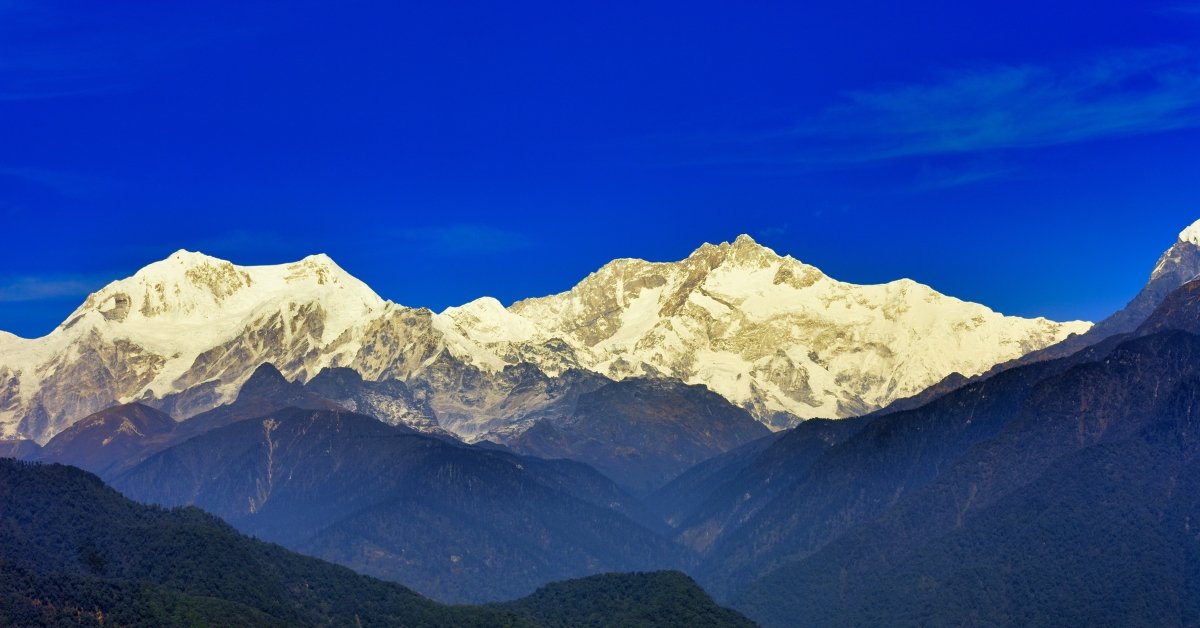
Did you know that Gurudongmar Lake is considered sacred because of a fascinating legend? It is said that Guru Padmasambhava, a revered Buddhist saint, touched the Lake to provide water for locals, ensuring a small portion never freezes, even in the harshest winters. This “holy spot” draws pilgrims and tourists alike, adding a spiritual layer to the Lake’s snowy beauty.
